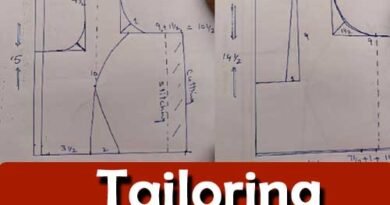Punjabi Collared Long Kurta
The Punjabi collared long kurta is a traditional garment worn by men in Punjab and other regions of Northern India. It is characterized by its distinct collar, typically standing upright, and its long length that often extends below the knees. In this class, we will explore the cultural significance, design elements, materials used, construction techniques, and styling tips for the Punjabi collared long kurta.
1. Cultural Significance
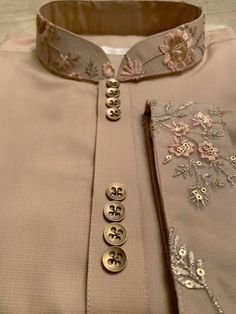
History and Tradition:
- The Punjabi collared long kurta has deep cultural roots in the Punjab region of India, known for its rich heritage and traditions.
- Historically, kurtas have been worn for centuries by men across various social and cultural contexts, evolving in style and design over time.
Occasions and Wear:
- Everyday Attire: It is commonly worn as everyday attire by men in Punjab and Northern India, offering comfort and practicality.
- Traditional Festivals: During festivals such as Diwali, Baisakhi, or weddings, men often wear elaborately designed kurtas as part of traditional attire.
- Ceremonial Functions: It is also worn on ceremonial occasions, religious ceremonies, and family gatherings, symbolizing cultural identity and pride.
2. Design Elements
A. Collar Style
1. Stand Collar:
- The defining feature of the Punjabi collared long kurta is its stand collar, which stands upright around the neck.
- The collar can vary in height and stiffness, adding to the overall appearance and style of the garment.
B. Length
1. Long Length:
- The kurta typically extends below the knees, providing coverage and comfort.
- The length can vary slightly depending on personal preference and regional variations.
C. Silhouette
1. Straight Cut:
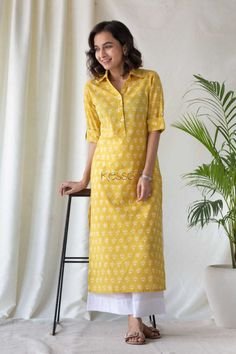
- The silhouette of the kurta is generally straight and loose-fitting, allowing for ease of movement and airflow.
- This style is comfortable for daily wear and suits a variety of body shapes.
D. Sleeves
1. Full Sleeves:
- Long sleeves are a common feature of the Punjabi collared long kurta, providing coverage and protection.
- Sleeves may end at the wrist or can be slightly longer, depending on individual preference.
3. Materials Used
A. Fabrics
1. Cotton:
- Cotton is a popular choice for kurtas due to its breathability, comfort, and suitability for warm climates.
- It is available in various weights and textures, from lightweight cotton for summer wear to thicker cotton blends for cooler weather.
2. Silk:
- Silk kurtas are considered more luxurious and are often worn for special occasions or festive celebrations.
- Silk adds a sheen and drape to the garment, enhancing its elegance and traditional appeal.
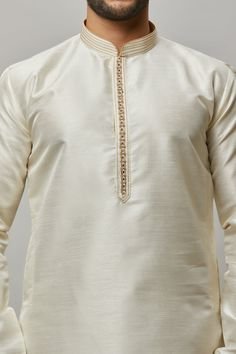
3. Linen:
- Linen kurtas are valued for their lightweight and breathable properties, making them suitable for hot and humid climates.
- Linen fabric has a natural texture that adds a casual yet refined look to the kurta.
B. Embellishments
1. Embroidery:
- Intricate embroidery work is a hallmark of Punjabi kurtas, often featuring traditional motifs such as paisleys, floral patterns, or geometric designs.
- Embroidery can be done using thread, sequins, beads, or zari (metallic thread), adding texture and richness to the garment.
2. Print and Patterns:
- Block printing, screen printing, or hand-painted designs are also used to decorate kurtas, showcasing regional craftsmanship and artistry.
- These patterns often reflect cultural motifs and symbols, making each kurta unique and meaningful.
4. Construction Techniques
A. Tailoring
1. Cutting and Stitching:
- Kurtas are typically cut in straight panels for the body and sleeves, minimizing waste and maximizing comfort.
- Skilled tailors ensure precise measurements and fittings, ensuring the kurta drapes well and fits comfortably.
B. Detailing
1. Collar Construction:
- The stand collar is carefully constructed to maintain its shape and structure.
- Interfacing or stiffening materials may be used to give the collar stability and durability.
2. Side Slits:
- Side slits are often incorporated into the kurta design for ease of movement and to enhance the overall fit.
- Slits can be reinforced with stitching to prevent tearing and add decorative detail.
C. Finishing
1. Hemming and Seams:
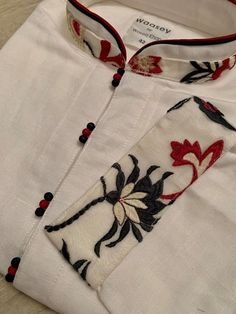
- The hem of the kurta and sleeves is neatly finished to ensure durability and a clean appearance.
- Double stitching or decorative stitching along seams adds strength and aesthetic appeal.
5. Styling Tips
A. Traditional Wear
1. Bottoms:
- Pair the Punjabi collared long kurta with traditional bottoms such as churidar (tight-fitting trousers with gathers at the ankle) or salwar (loose trousers tapering to a narrow fit at the ankle).
- Alternatively, wear it with dhoti pants for a more traditional look.
B. Modern Fusion
1. Western Influence:
- Combine the kurta with jeans or trousers for a fusion of traditional and modern styles.
- Accessorize with a belt or scarf to add a contemporary touch to the outfit.
C. Footwear and Accessories
1. Footwear:
- Complete the look with traditional footwear such as juttis (embroidered leather shoes) or mojaris (decorative slip-ons).
- For a modern twist, wear the kurta with loafers or sandals.
2. Accessories:
- Add traditional accessories such as a turban (pagri), stole (dupatta), or pocket square for a polished look.
- Consider wearing traditional jewelry such as a neckpiece (kanthi) or bracelet (kada) to complement the outfit.
6. Maintenance and Care
A. Washing Instructions
1. Fabric Care:
- Follow the care instructions provided on the garment label to maintain the fabric’s integrity and color.
- Hand wash or gentle machine wash kurtas to preserve embroidery and delicate fabrics.
B. Storage
1. Folding:
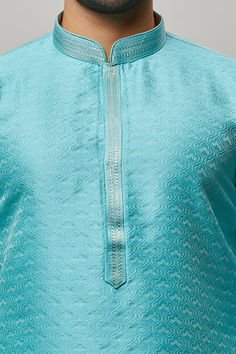
- Store kurtas folded neatly to prevent creasing and maintain their shape.
- Use breathable garment bags or cotton covers to protect kurtas from dust and insects.
7. Cultural Appropriation Considerations
Respect for Tradition:
- When wearing cultural attire like the Punjabi collared long kurta, it is important to understand and respect its cultural significance.
- Appreciate the craftsmanship and artistry behind the garment, acknowledging its roots in Punjabi culture and heritage.
Conclusion
The Punjabi collared long kurta is not just a garment but a cultural emblem that reflects the rich traditions and heritage of Punjab and Northern India. Its distinctive design elements, materials, construction techniques, and styling tips make it a versatile choice for everyday wear, festive occasions, and ceremonial events. By understanding its cultural significance and following appropriate styling and care practices, you can embrace the beauty and authenticity of the Punjabi collared long kurta in your wardrobe. Whether worn traditionally or in modern fusion styles, the kurta remains a timeless symbol of cultural identity and pride. Enjoy exploring and incorporating this iconic garment into your personal style journey!
